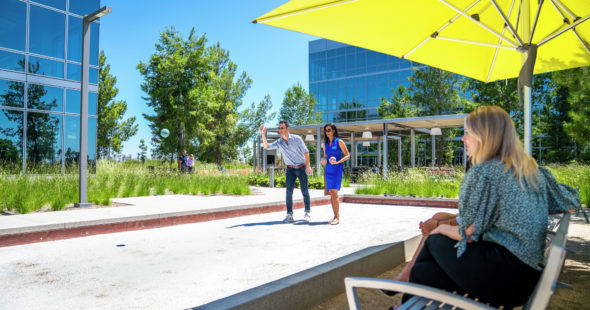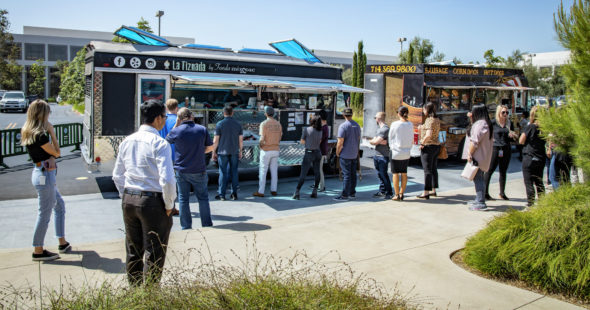
Four generations are now working together under one roof, and managers are grappling with diverse working preferences that impact everything from business growth to employee retention. Understanding these generational preferences is key to creating a supportive workplace environment where talent thrives.
Irvine Company Office sat down with Valerie Grubb, author of Clash of the Generations: Managing the New Workplace Reality to understand generational differences in work style. From addressing misconceptions about Millennials to the surprising similarities between Gen X and Gen Z work styles, Grubb sheds light on what managers need to know.
Why is the multigenerational workplace a timely issue?
We’ve been dealing with the challenges of the multigenerational workplace since Millennials entered the workforce a decade ago. Now, we’ve gone from three generations to four. Boomers aren’t retiring as fast as we thought they would, Gen X is squeezed between upper and middle management, Millennials are entering management, and Gen Z is entering the workplace.
Gen Z is very new to the workforce. What should managers know about this generation’s work style preferences?
Recent studies have shown some interesting similarities between how Gen X and Gen Z prefer to work. Both generations demonstrate a preference for working independently prior to coming together with a team. They don’t want to jump into a collaborative brainstorm. They say, “Give me some time to sit and think about this first.”
With Millennials, we saw a clear preference for teamwork and collaboration, which helped to popularize open plan offices. Gen Z is moving in a different direction.
This preference for individual work versus collaborative work is a key difference between Millennial and Gen Z work styles. In what ways are these generations similar?
First, these generations are much more interested than their predecessors in a company’s mission, vision and values. Second, they’re not inherently loyal to companies, which makes them harder to retain. You have to earn their loyalty by giving them a sense of purpose and actively helping them grow. Finally, both generations have a very high comfort level with technology; they expect communication and learning to be heavily technology enabled.
Millennials are often called lazy, which you believe is a misperception. How so?
Millennials can handle a lot more inputs than earlier generations so they bore easily and that boredom gets confused with laziness. They also want to know why they are doing the things they’ve been asked to do which can frustrate some managers, but I see this as a positive trait. I once had an employee in accounting who wasn’t paying our bills in a timely fashion. I said to her, “You have more of an influence on our brand than anybody else. The checks come from you, and if we don’t pay on time, that affects our reputation.” Once she made the connection between her role and brand enhancement she not only started paying bills on time but went to the different departments to help them process invoices faster so she could then cut checks faster. So was she lazy? Or was I not managing her properly?

How can the physical workspace help facilitate generational differences?
We have to be much more thoughtful about space because that can 100% have a major impact on productivity. There needs to be readily accessible space where employees can sequester themselves and analyze data, brainstorm, and focus on individual work before coming together.
However, it’s important to remember that when we discuss generational preferences, we’re talking in generalities.
It’s very powerful to ask employees what would help them perform better and give them some ownership over their space.
At Oxygen, for example, we asked the sales team what facility improvements could be made so they enjoyed their workspace better and one of the requests was to paint their office any color they wanted. One salesperson chose seafoam green and hot lips pink. It was just paint, but this simple change improved the motivation and job satisfaction of one of our top revenue generators!
As the result of generational preferences, many companies have adopted flexible work policies. How does that change the role of the office?
There’s a big divide here between generations. Baby Boomers, Gen X and older Millennials still choose to spend a lot of time in the office. They often have distractions at home that make remote work less appealing and they strongly prefer to engage in activities, like feedback and training, face-to-face.
Younger Millennials and Gen Z will likely spend a large portion of their time working elsewhere, assuming their companies have the right technology in place to allow for seamless remote work. For these employees, the office really becomes a gathering place to connect with colleagues, both for collaborative work and social interaction.
The workplace needs to be a fun, inspiring environment that motivates employees in a way that a coffee shop doesn’t.
Going back to the importance of mission to young people, that time in the office is very important for retention. The office is a major touchpoint for communicating mission and reinforcing culture. The right workplace will get employees excited about coming into the office.
Valerie M. Grubb is the author of Clash of the Generations: Managing in the New Workplace Reality (Wiley) and principal of HR consulting, coaching and training services company Val Grubb & Associates Ltd. She previously held a succession of leadership roles within corporations including NBC Universal, Oxygen Media, IAC and Rolls-Royce. valgrubbandassociates.com





